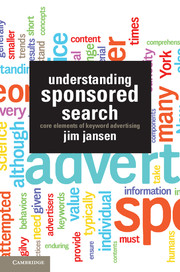Book contents
- Frontmatter
- Contents
- Preface
- Acknowledgments
- Notes on Terminology
- 1 A Context for Sponsored Search
- 2 Modeling the Process of Sponsored Search
- 3 Understanding Customer Intent for Keyphrase Selection
- 4 Sending Signals to the Customer with Ads
- 5 Understanding Consumer Behavior for Sponsored Search
- 6 BAM!: Branding, Advertising, and Marketing for Sponsored Search
- 7 Sponsored-Search Analytics
- 8 The Serious Game of Bidding on Keywords
- 9 Bringing It All Together in a Framework of Sponsored Search
- 10 The Future of Sponsored Search
- Glossary
- Index
- References
7 - Sponsored-Search Analytics
Published online by Cambridge University Press: 05 August 2011
- Frontmatter
- Contents
- Preface
- Acknowledgments
- Notes on Terminology
- 1 A Context for Sponsored Search
- 2 Modeling the Process of Sponsored Search
- 3 Understanding Customer Intent for Keyphrase Selection
- 4 Sending Signals to the Customer with Ads
- 5 Understanding Consumer Behavior for Sponsored Search
- 6 BAM!: Branding, Advertising, and Marketing for Sponsored Search
- 7 Sponsored-Search Analytics
- 8 The Serious Game of Bidding on Keywords
- 9 Bringing It All Together in a Framework of Sponsored Search
- 10 The Future of Sponsored Search
- Glossary
- Index
- References
Summary
Half the money I spend on advertising is wasted; the trouble is, I don’t know which half.
John Wanamaker, American retailer, credited with creating the modern department store and modern concept of advertising (attributed)For our frame shop’s keyword advertising campaigns, we are now set and running, with an understanding of our customers as reflected in keyphrases and advertising copy. We have an understanding of the branding, marketing, and advertising aspects of our campaigns and how these campaigns relate to our business. We know who our customers are and how they behave. So, we are set.
- Type
- Chapter
- Information
- Understanding Sponsored SearchCore Elements of Keyword Advertising, pp. 148 - 175Publisher: Cambridge University PressPrint publication year: 2011



